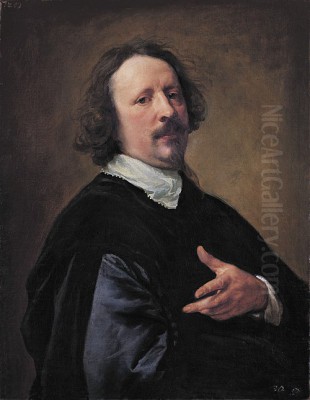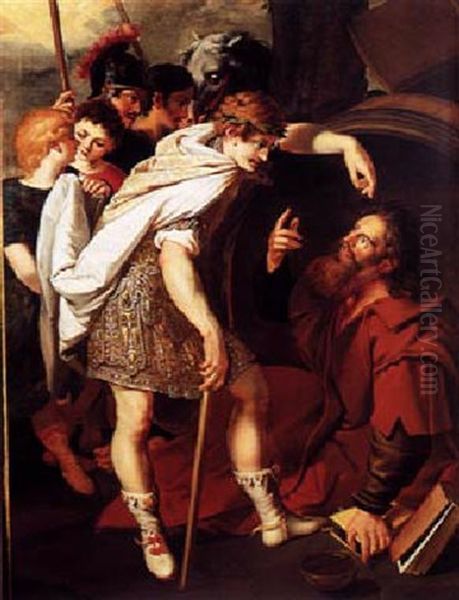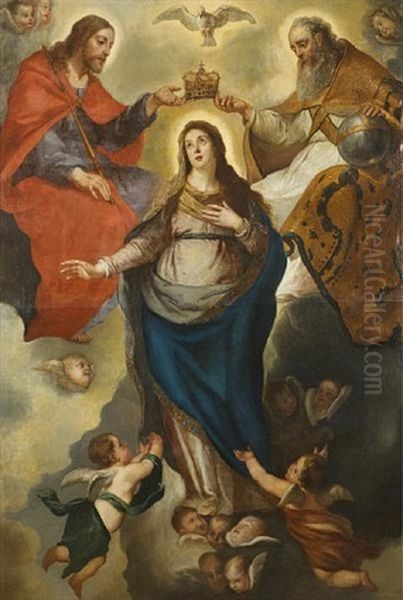
Caspar de Crayer stands as a significant figure in the rich tapestry of Flemish Baroque painting. Born during a period of intense artistic innovation and religious fervor, he carved out a distinct niche for himself, becoming one of the most sought-after painters of religious subjects and portraits in the Southern Netherlands during the 17th century. Though often discussed in relation to his towering contemporary, Peter Paul Rubens, De Crayer possessed a unique artistic voice, characterized by clarity, elegance, and profound devotional sentiment. His long and remarkably productive career spanned decades, leaving an indelible mark on the artistic landscapes of Brussels and Ghent.
Early Life and Artistic Formation in Brussels
Caspar de Crayer entered the world in Antwerp on November 18, 1584. His father, also named Gaspard, was an art dealer, illuminator, and decorative painter, suggesting an early immersion in the world of art. However, the family did not remain in the bustling art hub of Antwerp for long. They relocated to Brussels, the administrative heart of the Spanish Netherlands, which would become the primary stage for the first half of De Crayer's extensive career.
In Brussels, the young Caspar began his formal artistic training. He entered the workshop of Raphael Coxie (c. 1540–1616). Coxie was himself a painter of considerable repute, holding the title of court painter to the Archdukes Albert and Isabella, the governors of the Spanish Netherlands. Raphael was the son of the even more famous Michiel Coxie, sometimes dubbed the "Flemish Raphael" for his adherence to Italian High Renaissance ideals. Training under Raphael Coxie provided De Crayer with a solid foundation in drawing, composition, and the techniques favored by the Brussels school, which perhaps retained a slightly more conservative, classicizing tendency compared to the dynamic innovations emerging in Antwerp under Rubens.

De Crayer proved to be an adept student, quickly mastering the skills imparted by his teacher. By 1607, he was accomplished enough to be admitted as a master into the Brussels Guild of Saint Luke, the professional organization for painters and other artisans. This marked the official beginning of his independent career. His talent was readily apparent, and he soon began to receive commissions, laying the groundwork for his future success.
Establishing a Reputation: The Brussels Years
Membership in the Guild was not merely a professional certification; it integrated De Crayer into the artistic and social fabric of Brussels. He became an active member, eventually rising to prominence within the organization. He served as dean of the Guild on multiple occasions, including terms starting in 1616 and 1625. This position reflected the respect he commanded among his peers and his involvement in the city's artistic governance.
During these formative decades in Brussels, De Crayer steadily built his reputation. He specialized primarily in large-scale altarpieces for churches and monasteries, catering to the intense demand for religious art fueled by the Counter-Reformation. The Catholic Church, strongly supported by the Habsburg rulers, sought art that was clear, emotionally engaging, and doctrinally sound, aiming to inspire piety and reaffirm faith. De Crayer's style proved exceptionally well-suited to these requirements.
His early works show the influence of his training under Coxie but also reveal his awareness of broader artistic currents. He looked towards the dramatic intensity of late Mannerism but increasingly absorbed the innovations emanating from Antwerp, particularly the work of Peter Paul Rubens. While not a direct pupil of Rubens in the formal sense, De Crayer deeply admired and studied his work, adopting elements of his dynamic compositions, rich color palettes, and expressive figures.
He also excelled in portraiture, capturing the likenesses of local dignitaries, clergy, and members of the Brussels elite. His portraits from this period often display a sober elegance and psychological insight, demonstrating his versatility as an artist. He secured patronage from the highest levels, working for the Archdukes Albert and Isabella, continuing the connection established by his teacher, Raphael Coxie.
The Influence of Rubens and Van Dyck
The shadow of Peter Paul Rubens loomed large over Flemish art in the 17th century, and Caspar de Crayer was no exception. While based in Brussels, De Crayer was acutely aware of the artistic revolution Rubens was leading in nearby Antwerp. He absorbed many aspects of Rubens's style: the dynamic sense of movement, the robust physicality of figures, the rich, warm colors, and the complex, often diagonal, compositional structures typical of the High Baroque.

However, De Crayer adapted these elements into a style distinctly his own. Compared to Rubens's often tumultuous energy and sensuous textures, De Crayer's work frequently exhibits a greater sense of calm, clarity, and restraint. His color palette, while rich, could sometimes be cooler and brighter, and his compositions, though dynamic, often feel more ordered and legible. This clarity made his religious works particularly effective for devotional purposes within churches. Rubens himself reportedly held De Crayer in high regard, recognizing his exceptional talent. An anecdote, perhaps apocryphal but indicative of his standing, claims Rubens said of De Crayer's work, "Crayer, Crayer, no one will surpass you."
Another significant influence, particularly noticeable in De Crayer's later works and portraiture, was Anthony van Dyck. Van Dyck, initially Rubens's most brilliant assistant before embarking on an international career, brought a refined elegance and psychological subtlety to portraiture. De Crayer seems to have absorbed some of Van Dyck's sophisticated approach, visible in the graceful poses, delicate rendering of fabrics, and sensitive portrayal of his sitters. The connection between the two artists is further cemented by the fact that Van Dyck included a portrait of De Crayer in his Iconography, a series of prints depicting famous contemporaries.
De Crayer navigated these powerful influences skillfully, integrating aspects of both Rubens's dynamism and Van Dyck's elegance without sacrificing his own artistic identity. He remained committed to a certain classical balance and a clear narrative style, particularly in his religious commissions.
Court Painter and Major Commissions
De Crayer's rising stature culminated in prestigious appointments and commissions. Following the death of Archduchess Isabella in 1633, her nephew, the Cardinal-Infante Ferdinand of Austria, arrived in Brussels as the new governor of the Spanish Netherlands in 1634. Recognizing De Crayer's talent and established reputation, Ferdinand appointed him as his first court painter in 1635. This was a significant honor, placing De Crayer at the pinnacle of the artistic hierarchy in Brussels.
One of his major tasks associated with this appointment was contributing to the decorations for the Cardinal-Infante's Triumphal Entry into Ghent in 1635. Such events were elaborate public spectacles designed to display the power and legitimacy of the ruler, involving temporary arches, stages, and painted decorations. While Rubens was overseeing the grander Triumphal Entry into Antwerp, De Crayer played a key role in the Ghent festivities, further solidifying his connection with the ruling elite and the city of Ghent.
His position as court painter likely facilitated further commissions, not only from the Cardinal-Infante himself but also from the Spanish court. King Philip IV of Spain, a renowned art patron, commissioned numerous works from De Crayer, particularly large altarpieces destined for churches and monasteries throughout the Spanish empire. This royal patronage significantly enhanced De Crayer's international reputation. Many of his works found their way to Spain, where they were highly esteemed and can still be seen today.
These commissions often involved large-scale, multi-figure compositions depicting key moments from the lives of Christ, the Virgin Mary, and the saints. De Crayer excelled at managing these complex narratives, creating works that were both visually impressive and theologically resonant, perfectly aligning with the Counter-Reformation's goals for religious art.
Artistic Style: Clarity, Color, and Composition
Caspar de Crayer's artistic style is best understood as a masterful synthesis of various influences, adapted to his own temperament and the demands of his patrons. While fundamentally rooted in the Flemish Baroque tradition spearheaded by Rubens, it possesses distinct characteristics.
Compositionally, De Crayer favored clarity and legibility. Even in complex, multi-figure scenes, his arrangements tend to be well-ordered, often built upon stable diagonal or pyramidal structures. This ensures that the central narrative or devotional focus remains clear to the viewer. While capable of depicting dramatic movement, his compositions often possess a sense of balance and decorum appropriate for their ecclesiastical settings.
His use of color is notable. While influenced by Rubens's rich palette, De Crayer often employed cooler tones, particularly blues, pinks, and silvery grays, alongside warmer hues. This could lend his works a certain luminous quality and a feeling of refined elegance, distinguishing them from the more fiery palette sometimes associated with Rubens. His brushwork was fluid and confident, capable of rendering both the monumentality of figures and the delicate textures of fabrics.
In terms of emotional content, De Crayer's religious works convey sincere piety and devotion. His figures often express restrained sorrow, ecstatic faith, or gentle compassion, avoiding excessive melodrama. This dignified emotional tenor resonated well with the Counter-Reformation's emphasis on inspiring genuine religious feeling. He drew inspiration not only from his Flemish contemporaries but also from Italian masters. Echoes of the Venetian school, particularly Titian and Veronese, can be seen in his handling of color and light, while the classical grace of Bolognese painters like Guido Reni may also have informed his approach to idealized figures and expressions.
His portraits, while perhaps less numerous than his religious works, demonstrate equal skill. He captured accurate likenesses while imbuing his sitters with an air of dignity and status, employing sophisticated poses and paying close attention to the rendering of clothing and accessories, reflecting the influence of Van Dyck.
Collaboration in the Workshop
Like many successful Baroque masters, Caspar de Crayer maintained an active workshop and frequently collaborated with other specialized artists. This practice was common and efficient, allowing the master painter to focus on the most critical parts of the composition, typically the figures, while specialists handled elements like landscapes, architectural backgrounds, or still-life details.
Archival evidence and stylistic analysis indicate that De Crayer collaborated with several prominent landscape painters based in Brussels. These included Jacques Fouquier (or Focquier), Lucas Achtschellinck, and Lodewijk de Vadder. These artists would paint the landscape settings for De Crayer's historical or religious scenes, seamlessly integrating their work with his figures. This division of labor allowed for the creation of large, complex canvases more rapidly and leveraged the specific expertise of each artist.
He is also known to have collaborated occasionally with still-life painters, such as Gaspar Peeter Verbruggen the Elder, who might add elaborate floral garlands or swags to De Crayer's compositions, particularly in works combining portraiture or religious figures with decorative elements. These collaborations highlight the interconnected nature of the Brussels art world and the pragmatic approaches artists took to meet the demands of their patrons. De Crayer's ability to successfully integrate the work of specialists into his own compositions speaks to his skill as both an artist and an organizer.
Masterpieces and Representative Works
Caspar de Crayer's prolific output means numerous works survive, housed in churches and museums across Europe. Several stand out as particularly representative of his style and skill.
Among his most powerful religious works is the Ecce Homo (Behold the Man), located in the Convent of Santa Paula in Seville, Spain. Painted likely between 1640 and 1656, this work depicts Christ presented to the crowd, wearing the crown of thorns. De Crayer masterfully conveys Christ's suffering and dignity through subtle expression and the dramatic use of light and shadow, creating a deeply moving image for contemplation.
His Last Judgment, now in the Museum of Fine Arts, Ghent, is a monumental altarpiece showcasing his ability to handle vast, complex compositions. It depicts the dramatic scene with clarity and force, balancing the multitude of figures – the saved ascending to heaven and the damned cast into hell – around the central figure of Christ. The work demonstrates his command of anatomy, dynamic posing, and emotional range.
Another significant work, reflecting his Spanish patronage, is the Martyrdom of Saint Andrew, housed in the Prado Museum, Madrid. This large canvas depicts the apostle's crucifixion with characteristic clarity and devotional intensity. The composition focuses attention on the saint's suffering and faith, typical of Counter-Reformation martyr scenes.
De Crayer also painted mythological and historical subjects, although less frequently than religious ones. Alexander and Diogenes, found in the Wallraf-Richartz Museum in Cologne, shows his ability to handle classical themes, depicting the famous encounter between the powerful ruler and the ascetic philosopher with narrative clarity and well-observed characterization.
His portraits, such as those of the Cardinal-Infante Ferdinand of Austria and King Philip IV of Spain, demonstrate his skill in capturing likeness and conveying status. He also painted numerous portraits of prominent clergy and local nobility, contributing significantly to the genre in Brussels and later Ghent. Many churches in Ghent, such as St. Bavo's Cathedral, St. Michael's Church, and the former St. Peter's Abbey, still hold impressive altarpieces by De Crayer, testament to his activity in his later years.
The Move to Ghent and Later Career
In 1664, at the advanced age of nearly 80, Caspar de Crayer made a significant life change: he moved from Brussels, where he had lived and worked for over six decades, to Ghent. The reasons for this move are not entirely clear but may have been related to the strong connections he had already forged with Ghent through commissions like the Triumphal Entry decorations and numerous altarpieces for the city's churches. Ghent offered substantial opportunities for patronage, particularly from its wealthy abbeys and religious institutions.
Despite his age, De Crayer remained remarkably active and productive in Ghent. He established a workshop and quickly became the dominant figure in the local art scene. The demand for his work, particularly large altarpieces, continued unabated. He received major commissions from St. Bavo's Cathedral, St. Michael's Church, St. Peter's Abbey, and other religious foundations in and around the city. His late style maintained its characteristic clarity and elegance, though some works show a slightly looser brushwork and perhaps an even greater emphasis on tender, pious emotion.
His presence invigorated the artistic life of Ghent. He took on pupils and employed assistants, ensuring the continuation of his stylistic influence. His workshop became a major center for the production of religious art in the region. He continued working almost until his death, demonstrating extraordinary stamina and dedication to his craft.
Workshop, Pupils, and Influence in Ghent
During his final years in Ghent, Caspar de Crayer's workshop was highly productive. He trained and influenced a number of younger artists who helped propagate his style. Among his most notable pupils or workshop assistants from this period was Jan van Cleef III (also spelled Cleve), who became a respected painter in Ghent in his own right, continuing De Crayer's tradition of creating large-scale religious works.
Other artists associated with his Ghent workshop or circle of influence include Nicholas de Liemaecker (sometimes known as Nicolaas de Liemaecker or Roose) and Anselm van den Herreweghe. These painters absorbed De Crayer's compositional clarity, figural types, and devotional tone, ensuring that his artistic legacy endured in Ghent long after his death. While the exact nature of Gerard Seghers's connection to De Crayer remains debated by art historians – whether he was a pupil or merely influenced – Seghers certainly operated within the same broader artistic milieu of the Flemish Baroque.
De Crayer's influence extended beyond his direct pupils. His numerous altarpieces, prominently displayed in Ghent's major churches, served as models for subsequent generations of local artists. He effectively established a 'De Crayer school' in Ghent, characterized by its adherence to the principles of the High Baroque but tempered with a specific elegance and clarity derived from his personal style. His impact on the artistic identity of Ghent in the later 17th century was profound. He also influenced painters in other regions; for instance, the Dutch painter Jan Thys (or Tys) is noted to have been significantly influenced by De Crayer's approach to history painting.
Legacy and Reputation
Caspar de Crayer died in Ghent on January 27, 1669, at the remarkable age of 84. He left behind a vast body of work and a significant artistic legacy. He was one of the most successful and prolific painters of the Flemish Baroque, second perhaps only to Rubens and Van Dyck in terms of output and contemporary renown, particularly in Brussels and Ghent.
His primary contribution lies in his masterful synthesis and dissemination of the High Baroque style, particularly in the realm of religious art. He successfully adapted the dynamism of Rubens and the elegance of Van Dyck into a clear, accessible, and emotionally resonant style that perfectly met the needs of the Counter-Reformation Church and his patrons. His altarpieces graced countless churches in the Southern Netherlands and Spain, shaping the visual piety of the era.
While sometimes viewed by later art historians as less innovative than Rubens or Van Dyck, De Crayer was undeniably a master craftsman with exceptional skill in composition, color, and figural representation. His ability to manage large-scale commissions and run a productive workshop was remarkable. He played a crucial role in sustaining a high level of artistic production in Brussels after Rubens's main activity centered in Antwerp, and he became the undisputed leading master in Ghent during his later years.
Today, his works are held in major museums worldwide, including the Prado in Madrid, the Louvre in Paris, the Kunsthistorisches Museum in Vienna, the Royal Museums of Fine Arts of Belgium in Brussels, and the Museum of Fine Arts in Ghent, as well as in numerous churches, particularly in Flanders and Spain. Caspar de Crayer remains a key figure for understanding the breadth and depth of the Flemish Baroque, a testament to his enduring talent and prolific career.